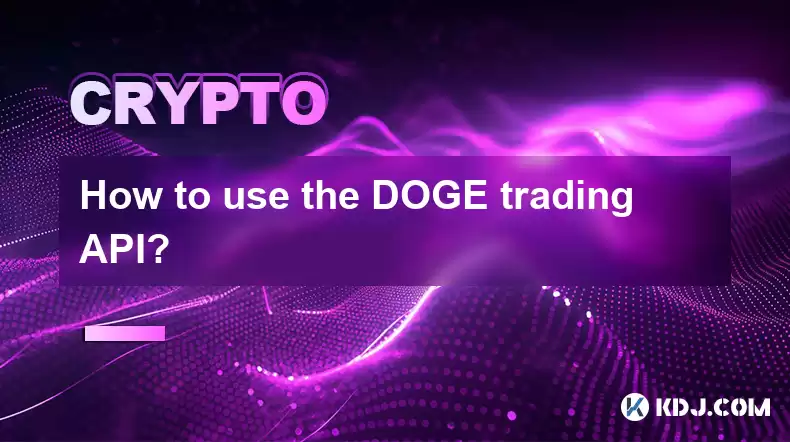-
 bitcoin
bitcoin $87959.907984 USD
1.34% -
 ethereum
ethereum $2920.497338 USD
3.04% -
 tether
tether $0.999775 USD
0.00% -
 xrp
xrp $2.237324 USD
8.12% -
 bnb
bnb $860.243768 USD
0.90% -
 solana
solana $138.089498 USD
5.43% -
 usd-coin
usd-coin $0.999807 USD
0.01% -
 tron
tron $0.272801 USD
-1.53% -
 dogecoin
dogecoin $0.150904 USD
2.96% -
 cardano
cardano $0.421635 USD
1.97% -
 hyperliquid
hyperliquid $32.152445 USD
2.23% -
 bitcoin-cash
bitcoin-cash $533.301069 USD
-1.94% -
 chainlink
chainlink $12.953417 USD
2.68% -
 unus-sed-leo
unus-sed-leo $9.535951 USD
0.73% -
 zcash
zcash $521.483386 USD
-2.87%
How to use the DOGE trading API?
The DOGE trading API allows traders to automate strategies, analyze trends, and execute trades efficiently on exchanges like Binance, Coinbase Pro, and Kraken.
Apr 19, 2025 at 02:50 am

Using the DOGE trading API can be a powerful tool for traders looking to automate their trading strategies, analyze market trends, and execute trades efficiently. The DOGE trading API, like other cryptocurrency trading APIs, provides a programmatic interface to interact with the DOGE market on various exchanges. In this article, we will guide you through the steps to use the DOGE trading API effectively, ensuring you understand how to leverage this tool for your trading needs.
Understanding the DOGE Trading API
Before diving into the practical use of the DOGE trading API, it's essential to understand what it is and what it can do. The DOGE trading API is a set of protocols and tools provided by cryptocurrency exchanges that allow developers and traders to interact with the market programmatically. This means you can write code to automate tasks such as placing orders, retrieving market data, and analyzing trading patterns without manually navigating through the exchange's user interface.
Choosing the Right Exchange
Different cryptocurrency exchanges offer DOGE trading APIs with varying levels of functionality and ease of use. Popular exchanges for DOGE trading include Binance, Coinbase Pro, and Kraken. When choosing an exchange, consider factors such as the API's documentation quality, the exchange's trading volume, and the fees associated with using the API. For this guide, we will use Binance as an example due to its comprehensive API and high DOGE trading volume.
Setting Up Your API Keys
To use the DOGE trading API, you first need to set up API keys on your chosen exchange. Here's how to do it on Binance:
- Log into your Binance account.
- Navigate to the API Management section, typically found under the account settings.
- Create a new API key. You will be prompted to enter a label for the key and to confirm your password.
- Enable the necessary permissions for your API key. For DOGE trading, you will likely need permissions for spot trading and market data access.
- Save your API key and secret. Keep these secure, as they grant access to your account.
Installing the Necessary Libraries
To interact with the DOGE trading API, you will need to use a programming language and relevant libraries. Python is a popular choice due to its simplicity and the availability of libraries like ccxt and binance-connector. Here's how to set up Python and the ccxt library:
- Install Python if you haven't already. You can download it from the official Python website.
- Open a terminal or command prompt and install the
ccxtlibrary by runningpip install ccxt. - Import the library in your Python script with
import ccxt.
Connecting to the DOGE Trading API
Once you have your API keys and the necessary libraries installed, you can connect to the DOGE trading API. Here's how to do it using ccxt:
- Initialize the exchange object with your API keys:
exchange = ccxt.binance({'apiKey': 'YOUR_API_KEY', 'secret': 'YOUR_SECRET_KEY',})
- Load the DOGE/USDT market data:
market = exchange.load_markets()['DOGE/USDT']
Placing Orders with the DOGE Trading API
Now that you're connected to the DOGE trading API, you can start placing orders. Here's how to place a market order to buy DOGE:
- Define the order parameters:
order = exchange.create_market_buy_order('DOGE/USDT', 100) # Buying 100 DOGE - Execute the order:
result = exchange.create_order('DOGE/USDT', 'market', 'buy', 100) - Check the order status:
order_info = exchange.fetch_order(result['id'], 'DOGE/USDT')print(order_info)
Retrieving Market Data
To make informed trading decisions, you'll need to retrieve and analyze market data. Here's how to fetch the DOGE/USDT order book:
- Fetch the order book:
order_book = exchange.fetch_order_book('DOGE/USDT')print(order_book) - Fetch historical candlestick data:
ohlcv = exchange.fetch_ohlcv('DOGE/USDT', '1h')print(ohlcv)
Automating Trading Strategies
With the DOGE trading API, you can automate your trading strategies. Here's a simple example of a moving average crossover strategy:
- Fetch historical price data:
ohlcv = exchange.fetch_ohlcv('DOGE/USDT', '1h') - Calculate moving averages:
import pandas as pddf = pd.DataFrame(ohlcv, columns=['timestamp', 'open', 'high', 'low', 'close', 'volume'])df['short_ma'] = df['close'].rolling(window=10).mean()df['long_ma'] = df['close'].rolling(window=30).mean() - Implement the trading logic:
if df['short_ma'].iloc[-1] > df['long_ma'].iloc[-1]:exchange.create_market_buy_order('DOGE/USDT', 100)elif df['short_ma'].iloc[-1]
exchange.create_market_sell_order('DOGE/USDT', 100)
Handling API Rate Limits
Cryptocurrency exchanges impose rate limits on API requests to prevent abuse. To handle these limits, you need to implement proper error handling and request throttling. Here's how you can do it in Python:
Implement error handling:
try: result = exchange.fetch_order_book('DOGE/USDT')except ccxt.RateLimitExceeded as e:
print(f'Rate limit exceeded: {e}') time.sleep(1) # Wait for 1 second before retrying result = exchange.fetch_order_book('DOGE/USDT')Use request throttling:
import timelast_request_time = 0def throttle_request():
global last_request_time current_time = time.time() if current_time - last_request_timethrottle_request()result = exchange.fetch_order_book('DOGE/USDT')
FAQs
Q: Can I use the DOGE trading API to trade on multiple exchanges simultaneously?A: Yes, you can use libraries like ccxt to interact with multiple exchanges at the same time. However, you will need to manage API keys and handle rate limits for each exchange separately.
A: Yes, using the DOGE trading API involves risks such as potential security breaches if your API keys are compromised, and the possibility of errors in your code leading to unintended trades. Always use secure practices and thoroughly test your code before deploying it in a live trading environment.
Q: How can I ensure my API keys are secure?A: To ensure the security of your API keys, never share them with anyone, use strong passwords for your exchange accounts, enable two-factor authentication (2FA), and consider using environment variables or a secure key management system to store your keys.
Q: Can I backtest my trading strategies using the DOGE trading API?A: While the DOGE trading API itself does not provide backtesting capabilities, you can use historical data fetched through the API to backtest your strategies using external libraries like backtrader or zipline.
Disclaimer:info@kdj.com
The information provided is not trading advice. kdj.com does not assume any responsibility for any investments made based on the information provided in this article. Cryptocurrencies are highly volatile and it is highly recommended that you invest with caution after thorough research!
If you believe that the content used on this website infringes your copyright, please contact us immediately (info@kdj.com) and we will delete it promptly.
- Grayscale Eyes 2026 Bitcoin All-Time High Amidst Institutional Era
- 2025-12-24 19:20:01
- Wintermute's Year-End Moves Stir Crypto Pot: Bitcoin Dominance, Altcoin Season, and Manipulation Whispers
- 2025-12-24 19:15:01
- Ethereum Price: Alarming Patterns and Price Prediction Amidst Shifting Market Dynamics
- 2025-12-24 19:10:01
- Crypto Price Prediction: Uniswap and Solana Brace for Impact Amidst Market Chill
- 2025-12-24 19:05:01
- Bitcoin, Ethereum, and the Crypto Market Navigate Technical Reset and Shifting Investor Sentiment
- 2025-12-24 19:15:01
- FxWirePro, Trending Coins, CoinGecko: The Wild Ride of Digital Assets Continues
- 2025-12-24 19:00:01
Related knowledge

The Ultimate Guide to Navigating Your First Crypto Bull Run
Dec 04,2025 at 02:00pm
Understanding the Crypto Bull Run Cycle1. A bull run in the cryptocurrency market is characterized by a sustained increase in asset prices, often driv...

An Investor's Primer on Bitcoin and Digital Assets
Dec 05,2025 at 07:59pm
Understanding Bitcoin and Its Role in Modern Finance1. Bitcoin emerged in 2009 as the first decentralized digital currency, operating on a peer-to-pee...

The Definitive Guide to Cryptocurrency for Beginners in 2025
Dec 11,2025 at 12:00pm
Understanding the Basics of Cryptocurrency1. Cryptocurrency is a form of digital or virtual currency that relies on cryptography for security and oper...

Everything You Need to Know About Crypto Before Investing
Dec 09,2025 at 04:19pm
Understanding the Basics of Cryptocurrency1. Cryptocurrency is a digital or virtual form of currency that uses cryptography for security and operates ...

The Ultimate Guide to Your First Year in Crypto
Dec 17,2025 at 10:00pm
Your First Steps into the Crypto World1. Entering the cryptocurrency space begins with understanding the foundational concept: blockchain technology. ...

A Simple, No-Nonsense Guide to Cryptocurrency
Dec 18,2025 at 02:40pm
What Is Cryptocurrency?1. Cryptocurrency is a digital or virtual form of money that uses cryptography for security and operates independently of a cen...

The Ultimate Guide to Navigating Your First Crypto Bull Run
Dec 04,2025 at 02:00pm
Understanding the Crypto Bull Run Cycle1. A bull run in the cryptocurrency market is characterized by a sustained increase in asset prices, often driv...

An Investor's Primer on Bitcoin and Digital Assets
Dec 05,2025 at 07:59pm
Understanding Bitcoin and Its Role in Modern Finance1. Bitcoin emerged in 2009 as the first decentralized digital currency, operating on a peer-to-pee...

The Definitive Guide to Cryptocurrency for Beginners in 2025
Dec 11,2025 at 12:00pm
Understanding the Basics of Cryptocurrency1. Cryptocurrency is a form of digital or virtual currency that relies on cryptography for security and oper...

Everything You Need to Know About Crypto Before Investing
Dec 09,2025 at 04:19pm
Understanding the Basics of Cryptocurrency1. Cryptocurrency is a digital or virtual form of currency that uses cryptography for security and operates ...

The Ultimate Guide to Your First Year in Crypto
Dec 17,2025 at 10:00pm
Your First Steps into the Crypto World1. Entering the cryptocurrency space begins with understanding the foundational concept: blockchain technology. ...

A Simple, No-Nonsense Guide to Cryptocurrency
Dec 18,2025 at 02:40pm
What Is Cryptocurrency?1. Cryptocurrency is a digital or virtual form of money that uses cryptography for security and operates independently of a cen...
See all articles










































































